|
|
|
|
MUDRA
HAND GESTURES WITH RELIGIOUS MEANING

Origin = India, Sanskrit = Mudrā
Chn = Yìn Xiàng 印相, Krn = Insang 인상
Jp = Insō, Inzō 印相, lit. “seal” or “sign”
Also known as Kakunin-in 確認印 in Japan
 In Buddhist sculpture and painting throughout Asia, the Buddha (Nyorai, Tathagata) are generally depicted with a characteristic hand gesture known as a mudra. Mudras are used primarily to indicate the nature and function of the deity. They are also used routinely by current-day Japanese monks in their spiritual exercises and worship. Knowledge of these hand gestures can help greatly in identifying Buddha images (less so when trying to identify Bodhisattva / Bosatsu images). But there is much variation and overlap among the mudra, and traditions in Japan differ from those in mainland Asia, so one should not depend exclusively on mudra for identification. In Buddhist sculpture and painting throughout Asia, the Buddha (Nyorai, Tathagata) are generally depicted with a characteristic hand gesture known as a mudra. Mudras are used primarily to indicate the nature and function of the deity. They are also used routinely by current-day Japanese monks in their spiritual exercises and worship. Knowledge of these hand gestures can help greatly in identifying Buddha images (less so when trying to identify Bodhisattva / Bosatsu images). But there is much variation and overlap among the mudra, and traditions in Japan differ from those in mainland Asia, so one should not depend exclusively on mudra for identification.
The most widely known mudra in Japan are those associated with the Five Buddha of Wisdom (Jp = Godai Nyorai, Gochi Nyorai), a grouping that originated in India, as did most Buddhist iconography. The five are eminations of Buddha nature. They embody five fundamental wisdoms -- wisdom against anger, envy, desire, ignorance, and pride -- to help us break free from the cycle of death and rebirth (samsara). Each of the five has a specific mudra that corresponds to one of the five defining episodes in the life of the Historical Buddha (see charts below). Each of the five is also associated with a compass direction, color, and other attributes. In Japan, only two of the Five Buddha are still widely reverred. The five are:
 |
|
Japanese
|
Sanskrit
|
Description & Photo
|
|
Tenbōrin-in
転法輪印 or Turning the Wheel of Law Mudra
Seppō-in
Setsubō-in
説法印 or Exposition of the Dharma Mudra
Associated with Dainichi; appears also with images of Shaka, Amida, and others
Converts ignorance and bewilderment into the wisdom of primordial awareness
|

Dharmachakra Mudra
Turning the Wheel of Law Mudra
Teaching Mudra
Preaching Mudra
Dharma Wheel Mudra
Vyakhyana Mudra
Exposition of the Dharma Mudra
Wisdom of Universal Lawfulness Mudra
White/Center/Zenith
|
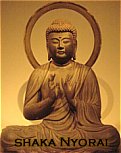  This gesture was used by Shaka Nyorai (the Historical Buddha) when preaching his first sermon after reaching enlightenment. It refers especially to the teaching of the Dharma (law) and the preaching of the Buddha. This gesture was used by Shaka Nyorai (the Historical Buddha) when preaching his first sermon after reaching enlightenment. It refers especially to the teaching of the Dharma (law) and the preaching of the Buddha.
This mudra is formed by holding the right hand with the palm turned outwards in front of the chest and joining the thumb and forefinger. Outside Japan, this mudra is known by various names:
- Vitarka (mudra of argumentation)
- Karana (mudra of religious action)
- Vyakhyana (mudra of exposition); known as the Seppō-in Mudra 説法印 in Japan
|
|
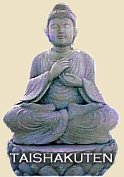 TEACHING MUDRA. The Sino-Japanese term Seppou-in is probably a translation of Vyakhyana. There are Japanese scholars who believe the Tenbourin-in (Skt. Dharmacakra Mudra) and Seppou-in (Skt. Vyakhyana Mudra), are identical. Some Japanese say the Seppou-in formed by joining the thumb and forefinger symbolizes the "Dharma-body" (hosshin 法身; Skt. dharmakaya). Joining the thumb and middle finger symbolizes the "recompense-body" (hōjin 報身; Skt. sambhogakaya). Joining the thumb and third finger symbolizes the "transformation-body" (ōjin 応身; Skt. nirmanakaya). However, no similar interpretation is to be found elsewhere in Asia. <above paragraph courtesy of JAANUS dictionary> TEACHING MUDRA. The Sino-Japanese term Seppou-in is probably a translation of Vyakhyana. There are Japanese scholars who believe the Tenbourin-in (Skt. Dharmacakra Mudra) and Seppou-in (Skt. Vyakhyana Mudra), are identical. Some Japanese say the Seppou-in formed by joining the thumb and forefinger symbolizes the "Dharma-body" (hosshin 法身; Skt. dharmakaya). Joining the thumb and middle finger symbolizes the "recompense-body" (hōjin 報身; Skt. sambhogakaya). Joining the thumb and third finger symbolizes the "transformation-body" (ōjin 応身; Skt. nirmanakaya). However, no similar interpretation is to be found elsewhere in Asia. <above paragraph courtesy of JAANUS dictionary>
Dainichi Nyorai corresponds to the Historical Buddha's first turning of the Wheel of the Law at Deer Park in Sarnath (India), where Shaka gave his first sermon. The turning of the Dharma wheel is a metaphor for teaching the way of enlightenment.
QUOTE: This mudra “symbolizes the destruction of human ills, as well as the constant progression of Buddhist doctrines which penetrate to all Beings and which, without limits, like the cosmic wheel, exist universally. This is a symbolism which accentuates the movement of the wheel, a continual movement of the Law which is constantly being transmitted to all Beings." <end quote by E.D. Saunders>
|

 |
|
Japanese
|
Sanskrit
|
Description & Photo
|
|
Semui-in
施無畏印
Associated with Amogha-
siddhi (Jp:
Fukūjōju Nyorai) and Shaka Nyorai
Converts jealousy and envy into all accomplish-ing wisdom
|
Abhaya
Abhayadana Abhayaprada
“Fear Not”

Wisdom required by karma for its completion.
Green
North
|
 Gesture of fearlessness and the granting of protection; right hand lifted above right thigh with palm facing out, fingers pointing up. Said to be the gesture of Shaka Nyorai (Historical Buddha) immediately after attaining enlightenment. This mudra is often used in combination with the Varada Mudra (welcome mudra). Gesture of fearlessness and the granting of protection; right hand lifted above right thigh with palm facing out, fingers pointing up. Said to be the gesture of Shaka Nyorai (Historical Buddha) immediately after attaining enlightenment. This mudra is often used in combination with the Varada Mudra (welcome mudra).
Associated with Amoghasiddhi (Jp: Fukujoju Nyorai; not frequently found in Japanese Buddhist sculpture). Amoghasiddhi means “inevitable success.” The episode relates to the historical Buddha who, while in deep meditation in human form, was protected for seven days from stormy rain and wind by Mucilinda, the seven-headed serpent king who spread his heads above the Buddha. Mucilinda is one of the Naga, a grouping of powerful serpent beings, including the dragon, who converted to Buddhism after listening to the teachings of Shaka Nyorai; in Japan, the Naga are members of the Hachi-bushu (Eight Legions, Protectors of Buddhism).
|
|
 Fear Not Mudra, As quoted from JAANUS Fear Not Mudra, As quoted from JAANUS
The Japanese Architecture and Art Net Users System
Literally the “mudra for bestowing fearlessness.” A hand gesture in which the right hand, with its fingers extended, is held in front of the chest. In the iconography of Japanese Buddhism, images with the right hand displaying the semui-in and the left hand displaying the yogan-in are regarded as representing the general style for images of the Tathagatas (the Nyorai), and this type is termed the Tsuubutsugyou 通仏形 (lit. "form common to Buddhas"). Hence the semui-in is not restricted to images of Shaka, but is also widely used as the mudra of Yakushi, Miroku, and Fukuu Jouju in the Diamond World Mandala. This mudra is thought to have its orgins in an event that took place during Shaka's life. The malevolent Devadatta, wishing to kill Shaka, released on him an elephant maddened with alcohol, but the elephant was struck by Shaka's spiritual power and fell prostrate before him In order to emphasize Shaka's greatness, however, extant representations of this episode in India depict Shaka larger than the elephant, and as a result his right hand is often shown with the five fingers extended and the palm turned downwards as if to stroke the elephant's head. The origins of this mudra are not necessarily accepted by contemporary art historians. But in view of the fact that in Tibet the mudra turned downwards as in depictions of this subjugation of the maddened elephant is likewise called "granting protection" (skyabs sbyin), this interpretation is still highly possible. Images of Shaka displaying this semui-in are found in Buddhist countries throughout Asia, but there are few examples of its occurring in combination with the left hand forming the yogan-in, as is the case in Japan; instead the left hand is usually shown placed in the manner of the "meditation mudra" (zenjou-in), or holding a corner of the robes. <end JAANUS quote>
|

 |
|
Japanese
|
Sanskrit
|
Description & Photo
|
|
Yogan-in
与願印
Associated with Hōshō Nyorai, Kashō Butsu, and Shaka Nyorai
Chinese:
Baosheng Fo
Converts pride, greed and envy into the wisdom of equanimity; the wisdom of essential similarity
|
Varada
“Welcome”

Charity Mudra or Blessing Mudra
South
Yellow
Source of Secret Things
The One who Manages the Treasures
|
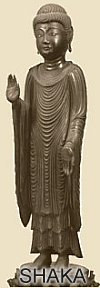 Primarily represents the granting of wishes to those who welcome the teachings of Buddhism; right hand points downward, with palm facing outward; left hand often used instead when combined with Abhaya Mudra. In a variant, thumb and index finger of hand touch each another. Primarily represents the granting of wishes to those who welcome the teachings of Buddhism; right hand points downward, with palm facing outward; left hand often used instead when combined with Abhaya Mudra. In a variant, thumb and index finger of hand touch each another.
Associated mostly with standing statues of the Buddha. When Shaka Nyorai is shown with this mudra, it symbolizes the summoning of heaven to witness his enlightenment.
This mudra corresponds to Hōshō Nyorai 宝生如来 (Skt. Ratnasambhava; not frequently found in Japanese Buddhist sculpture). Also corresponds to Kassapa or Kashō Butsu 迦葉仏 (Skt. Kasyapa), one of the Seven Buddha of the Past; Kasyapa was the Historical Buddha’s immediate predecessor.
|

 |
|
Japanese
|
Sanskrit
|
Description & Photo
|
|
Gōma-in
降魔印
also read
Sokuji-in
Shokuchi-in
触地印
Associated with Akshobhya; Ashuku Nyorai in Japan
Converts anger and aggression into mirror-like wisdom
|
Bhumisparsha
Earth as Witness
Mirror-like Wisdom
East
Blue
Subjugates demonic passions; manifests the pure spirit of wakefulness
|
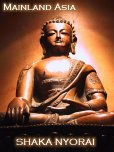 Literally "touching the earth;" associated with Shaka Nyorai, who touches ground to "call the earth to witness" his victory over temptation during his battle with Mara (the Evil One); made using both hands, with right hand hanging over right knee, palm inward, with finger(s) touching earth, while left hand positioned on lap with palm up. Literally "touching the earth;" associated with Shaka Nyorai, who touches ground to "call the earth to witness" his victory over temptation during his battle with Mara (the Evil One); made using both hands, with right hand hanging over right knee, palm inward, with finger(s) touching earth, while left hand positioned on lap with palm up.
 Sometimes the left hand holds a begging bowl; one of the most common mudra among seated Buddha in Asia; not so common in Japan however. Sometimes the left hand holds a begging bowl; one of the most common mudra among seated Buddha in Asia; not so common in Japan however.
This mudra corresponds to Ashuku Nyorai (Skt. Akshobhya), who is found mostly in the mandala of Japan’s Esoteric Buddhist sects. Yet, among Japan’s many Buddhist statues dating from the 8th century onward, Ashuku is seldom represented.
|

 |
|
Japanese
|
Sanskrit
|
Description & Photo
|
|
Zenjō-in
禅定印
Jō-in
定印
Jōin is an abbreviation of Zenjō-in, meaning “Meditation Mudra”
Hokkaijō-in
法界定印
Mudra of the Dharma Realm
------------
Hokkai means “Dharma Realm” (Skt = Dharmadhatu); thus Hokkaijō-in means “Meditation Mudra of the Dharma Realm”
In Japan,
this mudra is not used for images of Amida Nyorai
------------
Mida no jō-in
弥陀の定印
阿弥陀の定印
Also known as Rikitan-in 力端印
Mida is an abbreviation of Amida and associated specifically with Amida Nyorai
Converts desire, lust and passion into the wisdom of discriminating awareness.
The world-famous 15-meter Big Buddha Statue in Kamakura is Amida.
|
Dhyana
Meditation Mudra or Contemplation Mudra
In Japanese Esoteric Buddhism, Dainichi Nyorai emboides the wisdom of the essence of the Dharma realm.
------------
Mida jō-in
Meditation Mudra of Amida Nyorai
Wisdom of Distinction
One Whose Splendor
is Immeasurable
Buddha of the Afterlife
Buddha of the
Western Paradise
West / Red
|
 In Japan, this mudra is associated with Shaka Nyorai, Dainichi Nyorai, and Senju Kannon. Found mostly on seated images, but some standing images of the Senju Kannon are also shown with this hand gesture. Made by placing both hands in the lap, right on top of left, with palms turned upward and thumbs touching to form a circle. It symbolizes the Buddha in a state of meditation. In Japan, this mudra is associated with Shaka Nyorai, Dainichi Nyorai, and Senju Kannon. Found mostly on seated images, but some standing images of the Senju Kannon are also shown with this hand gesture. Made by placing both hands in the lap, right on top of left, with palms turned upward and thumbs touching to form a circle. It symbolizes the Buddha in a state of meditation.
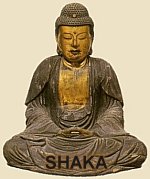 This mudra was extremely popular in Asia, and examples abound throughout the region. But in Japan, it was rarely used for images of Amida Nyorai. Instead, Amida is portrayed almost exclusively with the Mida no Jōin Mediation Mudra (see below). In Japanese iconography, the Meditation Mudra was differentiated into two types, with the ordinary Zenjō-in (also called Hokkaijō-in) used mainly for Dainichi Nyorai in the Womb-World Mandala (Taizoukai), and the Mida-no-jōin reserved specifically for images of Amida Nyorai. Despite this variation, both mudra are still translated as “meditation mudra.” In addition, Zen artwork frequently portrays Shaka (the Historical Buddha) with the ordinary meditation mudra, but the position of both hands is often reversed (left on top of right, not right on top of left). This is called Zenshūyō-no-Shaka (Shaka in the Style of the Zen Sect). This mudra was extremely popular in Asia, and examples abound throughout the region. But in Japan, it was rarely used for images of Amida Nyorai. Instead, Amida is portrayed almost exclusively with the Mida no Jōin Mediation Mudra (see below). In Japanese iconography, the Meditation Mudra was differentiated into two types, with the ordinary Zenjō-in (also called Hokkaijō-in) used mainly for Dainichi Nyorai in the Womb-World Mandala (Taizoukai), and the Mida-no-jōin reserved specifically for images of Amida Nyorai. Despite this variation, both mudra are still translated as “meditation mudra.” In addition, Zen artwork frequently portrays Shaka (the Historical Buddha) with the ordinary meditation mudra, but the position of both hands is often reversed (left on top of right, not right on top of left). This is called Zenshūyō-no-Shaka (Shaka in the Style of the Zen Sect).
 Mida no Jōin Meditation Mudra Mida no Jōin Meditation Mudra
This mudra is found almost exclusively in Japan and associated specifically with Amida Nyorai. In China, this mudra is rarely seen. Outside of Japan, Amida is mostly portrayed with the ordinary meditation mudra (the Zenjō-in, the Hokkaijō-in). In Japan, however, the ordinary meditation mudra was not used for images of Amida. Instead, the Mida-no-jōin was used to help differentiate between Dainichi and Amida.
 |
Formed by placing the right hand over the palm of the left hand, with tips of both thumbs touching lightly; hands rest in lap, palms up; right hand represents enlightenment; left hand represents world of appearance (illusions); this mudra symbolizes the triumph of enlightenment over the world of illusions; in a variant, the middle, ring, and little fingers of both hands lie on top of one another, with the thumbs and index finger of both hands touching each other, forming a circle. This mudra corresponds to the meditation of the historical Buddha under the sacred Bodhi tree, although there are several variations with different finger positions. The Mida-no-jouin is described in the Kongouchou Yuga Kanjizaiou Nyorai Rhugyouhou 金剛頂瑜伽観自在王如来修行法, which is thought to be the textual source of the mudra. <source JAANUS> |

 |
|
Japanese
|
Sanskrit
|
Description & Photo
|
|
Raigō-in
来迎印
Associated closely with Amida Nyorai
|
Vitarka
Reasoning Mudra
Teaching Mudra
Discussion Mudra
|
 Closely related to the Dharmachakra mudra; right hand points upward, left downward; both palms turned outward, with the thumb and index finger on each hand forming a circle; right hand at shoulder level, left hand at hip level. Closely related to the Dharmachakra mudra; right hand points upward, left downward; both palms turned outward, with the thumb and index finger on each hand forming a circle; right hand at shoulder level, left hand at hip level.
In a variant, left hand rests palm upward in lap, with right hand raised to shoulder level with thumb and index finger forming circle; in another variant, the index finger and little fingers on both hands are extended, but the middle and ring fingers are curved inward slightly, with left hand pointing up and right hand pointing down.

Variations
|
|
The term Raigō-in 来迎印, or welcoming mudra, is only applied to Amida Nyorai. It refers specifically to nine different mudra used by Amida when welcoming the dead into the Pure Land (Jōdo 浄土) of Ultimate Bliss (Gokuraku 極楽). These nine are known as Amida Kubon-in 阿弥陀九品印 (also read Amida Kuhon-in), meaning “Mudra of the Nine Levels of Rebirth.” Amida’s Pure Land is composed of nine different levels or grades, and devotees are reborn into one of the nine. In Japan, the nine levels are sometimes represented in Amida paintings and sculpture by nine different mudra (hand gestures).
|
Upper Grade
Jōshō 上生
|

Upper, Upper Birth
Jōbon Jōshō 上品上生
|

Upper, Middle Birth
Chūbon Jōshō 中品上生
|

Upper, Lower Birth
Gebon Jōshō 下品上生
|
|
|
|
Middle Grade
Chūshō 中生
|

Middle, Upper Birth
Jōbon Chūshō 上品中生
|

Middle, Middle Birth
Chūbon Chūshō 中品中生
|
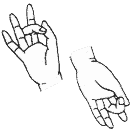
Middle, Lower Birth
Gebon Chūshō 下品中生
|
|
|
|
Lower Grade
Geshō 下生
|

Lower, Upper Birth
Jōbon Geshō 上品下生
|

Lower, Middle Birth
Chūbon Geshō 中品下生
|
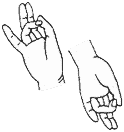
Lower, Lower Birth
Gebon Geshō 下品下生
|
|
Source of Clipart: Web Site of Jodo Shu Headquarters, Honen Buddhism
|
|
|

 |
|
Japanese
|
Sanskrit
|
Description & Photo
|
|
Chiken-in
智拳印
Also called
Kakushō-in 覚勝印 or "Mudra of Supreme Enlightenment”
Associated with Dainichi Nyorai
Converts ignorance and bewilderment into wisdom of primordial awareness
CHI 智 = the intellectual power to destroy passions of this world and attain Buddhahood
|
Vajra
Mudra of
Six Elements
Supreme Wisdom
Fist of Wisdom
One of Five
Buddha of Wisdom
Buddha of
the Center
Embodies Omniscience and Wisdom of Universal Lawfulness
In Sanskrit, Dainichi is known as
Vairocana or Mahavairocana
|
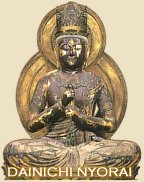 Characteristic gesture of Dainichi Nyorai in Japan and Korea; outside Japan, Dainichi is typically represented with the teaching (preaching) gesture, the Dharmacakra mudra, for Dainichi corresponds to the historical Buddha's first turning of the Wheel of the Law at Deer Park in Sarnath (India), where Shaka Nyorai gave his first sermon after reaching enlightenment. Characteristic gesture of Dainichi Nyorai in Japan and Korea; outside Japan, Dainichi is typically represented with the teaching (preaching) gesture, the Dharmacakra mudra, for Dainichi corresponds to the historical Buddha's first turning of the Wheel of the Law at Deer Park in Sarnath (India), where Shaka Nyorai gave his first sermon after reaching enlightenment.
Dainichi is also sometimes shown holding a medicine jar in the left hand while the right hand forms the Abhaya or the Varada mudra.
 The Vajra mudra is formed by grasping the raised forefinger of the clenched left hand with the clenched right hand, with the tip of the right forefinger touching (or curled around) the tip of the left forefinger. This is also known as the six elements mudra, or the fist of wisdom mudra, for it symbolizes the unity of the five worldly elements (earth, water, fire, air, and metal) with spiritual consciousness. In Japan, Dainichi Nyorai is especially important to adherents of Esoteric Buddhism (Shingon). The Vajra mudra is formed by grasping the raised forefinger of the clenched left hand with the clenched right hand, with the tip of the right forefinger touching (or curled around) the tip of the left forefinger. This is also known as the six elements mudra, or the fist of wisdom mudra, for it symbolizes the unity of the five worldly elements (earth, water, fire, air, and metal) with spiritual consciousness. In Japan, Dainichi Nyorai is especially important to adherents of Esoteric Buddhism (Shingon).
|
|
SIX ELEMENTS MUDRA
“The Vajra Mudra is typical of Korea and Japan, but is somewhat rare in India, so it should perhaps more appropriately be identified by its Japanese name of Chi Ken-in.” <Quote from Oriental Artifacts>
<Quote from JAANUS> Literally “knowledge-fist mudra.” There are some examples, although rare, in which the positions of the left and right hands are reversed (e.g., image of Dainichi at Oomishima Jinja 大三島神社, Ehime Prefecture). In India this mudra was known as either jnanamusti mudra or bodhyagri mudra. In Japan it is generally known as chiken-in. In the iconography of Indo-Tibetan Buddhism, however, the term bodhyagri-mudra was generally used, and this is translated in Japan as kakushou-in 覚勝印 or "mudra of supreme enlightenment." There are various theories on the origins and symbolism of this mudra. According to some authorities, it is derived from the tenbourin-in (teaching murdra), while others equate the left hand with the male organ and the right hand with the female organ, and maintain that it represents, by means of sexual symbolism, the central deity of the mandala from which all the other deities emanate. According to the traditional interpretation of Japanese Esoteric Buddhism, however, the left and right hands represent sentient beings and Buddhas respectively, and this mudra is generally interpreted as symbolizing the mutual response of the buddha and sentient beings. The mudra is most commonly seen in images of Dainichi in the Diamond World Mandala (Kongoukai Mandara 金剛界曼荼羅), but is also found on other deities affiliated with Esoteric Buddhism, such as Ichijikinrin Butchou 一字金輪仏頂 (e.g., Chuusonji 中尊寺 in Hiraizumi 平泉, Iwate prefecture), Sonshou Butchou 尊勝仏頂 (e.g., central deity of the East Stupa on Mt. Kouya 高野), and Daishou Kongou 大勝金剛. <end quote from JAANUS>
SIX ELEMENTS 六界, Jp. = Rokukai ろくかい
In Esoteric Buddhism, the five elements (Jp. = Goshiki 五行) are combined with one additional element, the MIND, for a total of six. Statues or paintings of Dainichi Buddha, the central deity of Esoteric Buddhism in Japan, often portray Dainichi with a characteristic hand gesture called the Mudra of Six Elements (Chiken-in 智拳印), in which the index finger of the left hand is clasped by the five fingers of the right. This mudra symbolizes the unity of the five worldly elements (earth, water, fire, air, and space) with a six element, spiritual consciousness. (Note: This grouping of five elements differs somewhat from the Chinese grouping of five.) To some, this mudra equate the left hand with the male organ and the right hand with the female organ, and maintain that it represents, by means of sexual symbolism, the central deity of the mandala from which all the other deities emanate. According to another interpretation, the left hand represents sentient beings and the right hand the Buddha, and thus symbolizes the two-way response of the Buddha and sentient beings.
In the Mandala artform, which is of special importance to Japan’s Esoteric sects (Shingon, Tendai), the five elements are considered inanimate (this equates to the Garbhadhatu or Womb World Mandala). Only by adding the sixth element -- mind, perception, or spiritual consciousness -- do the five become animate. This equates with the Vajradhatu or Diamond World Mandala. Phrased differently, there is “unity” only when the sixth element is added. Without the sixth element, ordinary eyes see only the differentiated forms or appearances.
- Earth
- Water
- Fire
- Air (or Wind)
- Space
- the MIND (spiritual consciousness or perception)
* jump to five elements page *
|

 |
|
Japanese
|
Sanskrit
|
Description & Photo
|
|
Gasshō 合掌
or
Gōjū 合十
Pressing one's hands together in prayer.
|
Anjali
Añjali
Namaskara
Namaskra
Namaste
Mudra of
Veneration
IN CHINA
Mudra of
Kwan Yin (Kannon)
and Yama
|
 Mudra of Greeting, Respect, Veneration. A symbolic gesture of reverence that symbolizes the unity of body and mind; also a monk's salutation. Mudra of Greeting, Respect, Veneration. A symbolic gesture of reverence that symbolizes the unity of body and mind; also a monk's salutation.
Palms held together at chest level (resembles Western image of praying hands); signifies respect, submission, and veneration, and therefore not found on statues of the Buddha (Nyorai).
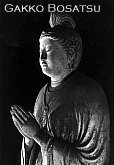 Common gesture used even today by Japanese worshippers to show respect to shrine and temple deities; also the customary gesture of greeting in India Common gesture used even today by Japanese worshippers to show respect to shrine and temple deities; also the customary gesture of greeting in India
|

 |
|
Japanese
|
Sanskrit
|
Description & Photos
|
|
Baku
縛
Gebaku
外縛
Naibaku
内縛
|
Bandha
Literally means “bind”
Mudra of Binding
Gebaku represents
one’s vow to become enlightened. It also symbolizes the heart and compassion of the Buddha.
Naibaku constitutes inner binding and represents the vow of the many Buddha to help all sentient beings.
|
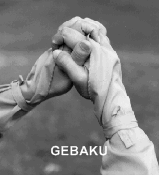 Below text Below text
courtesy JAANUS
Hand gesture formed by clasping both hands together with the fingers interlocking. When the fingers are interlocked on the outside, it is called gebaku (lit. "outer bind"), while when they are interlocked on the inside, it is called naibaku (lit. "inner bind").
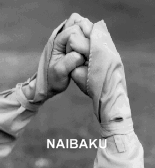 Because it formed the basis of many mudras, considerable importance was attached to it in Esoteric Buddhism (Mikkyou), and it was counted among the mother mudras, Immo 印母. Yet baku was seldom found in actual images or paintings. Because it formed the basis of many mudras, considerable importance was attached to it in Esoteric Buddhism (Mikkyou), and it was counted among the mother mudras, Immo 印母. Yet baku was seldom found in actual images or paintings.
When used, it was frequently in images of the arhat (rakan), or eminent monks, such as Fukuu (Skt: Amoghavajra; 705-774), one of the eight patriarchs of the Shingon Sect. Figures shown with the gebaku include Genbou (691-746), one of the six patriarchs of the Hossou Sect, and Daikashou (Skt: Mahakasyapa) in a triad with Shaka Nyorai, and Onanda (Jp: Anan). PHOTOS: www.skhquest.com/articles/ninjakuji.aspx
|

 |
|
Japanese
|
Sanskrit
|
Description & Photo
|
|
Unknown
Pending research
|
Uttarabodhi
Mudra of Supreme Enlightenment
|
 Hands held at chest level; index fingers on both hands are raised, touching each other; remaining fingers are crossed and folded down; thumbs are crossed and folded or are touching each other at tips; outside Japan, this mudra appears sometimes with images of Dainichi Nyorai (Vairocana). Hands held at chest level; index fingers on both hands are raised, touching each other; remaining fingers are crossed and folded down; thumbs are crossed and folded or are touching each other at tips; outside Japan, this mudra appears sometimes with images of Dainichi Nyorai (Vairocana).
|

|
Japanese
|
Sanskrit
|
Description & Photo
|
|
Unknown
Pending
research
|
Vajrapradama
Mudra of Unshakable Confidence
|
 The fingertips of the hands are crossed, representing unshakable confidence. The fingertips of the hands are crossed, representing unshakable confidence.
|

MORE EXAMPLES
Only the following mudras are used routinely in Theravada Buddhism:
- Gesture to assuage fear (Abhaya Mudra)
- Gesture of welcome or to make offering (Varada mudra)
- Gesture of preaching the Dharma (Dharmacakra mudra)
- Gesture of reasoning (Vitarka mudra)
- Gesture of meditation (Samadhi mudra)
- Gesture of calling earth to witness (Bumiparsa mudra)
NOTEBOOK (study notes):
- Shaka Nyorai's left hand is sometimes held with the palm upwards and the fingers outstretched (except the middle two, which may be curled in slightly to beckon people toward salvation).
- Yakushi Nyorai usually holds a medicine pot in his left hand.
- Amida Nyorai's left hand is shown with an inverted "okay" gesture, with the thumb and index finger forming a circle.
- Miroku Nyorai's left hand is usually pointing down.
Five Buddha Families, Five Major Energies, Five Wisdoms
Five Great Buddha of Wisdom
The Five Buddha of Meditation, The Five Jina, The Five Tathagatas
Wisdom against anger, envy, desire, ignorance, and pride
- Vajra (Diamond) Family. Converts anger and aggression into mirror-like wisdom; main Buddha figure is Ashuku Nyorai (Akshobhya); East; Blue; represents deep awareness of the sphere of reality; also represents mind (blue, center), space, and body consciousness
- Karma Family. Converts jealousy and envy into all-accomplishing wisdom; the wisdom required by karma for its completion; this family is represented by the sword; North; Green; associated with Fukujoju Nyorai (Amoghasiddhi) and Tara Bosatsu; embodies the accomplishing of deep awareness; this family also represents actions (green, north), the wind, and tongue consciousness.
- Padma (Lotus) Family. Converts desire, lust and passion into the wisdom of discriminating awareness, or the wisdom of distinction; main Buddha figures are Amida Nyorai (Amitabha) and Kannon Bosatsu (Avalokiteshvara); West; Red; family also represents speech (red, west), fire, and nose consciousness.
- Tathagata (Buddha) Family. Converts ignorance and bewilderment into the wisdom of primordial awareness, or the wisdom of universal lawfulness; family is represented by the Wheel (turning the wheel of the law), and associated with Dainichi Nyorai (Vairochana or Mahavairocana); Center or Zenith; White; the primordial Buddha, the cosmic Buddha; represents deep awareness of the sphere of reality, the dharma realm (Skt. dharmadhatu); also represents body, earth, and eye consciousness.
- Ratna (Jewel) Family. Converts pride, greed, and envy into the wisdom of equanimity, or the wisdom of essential similarity; main Buddha figure is Hosho Nyorai (Ratnasambhava); South; Yellow; this family also represents deep awareness of equalities, goodness (yellow, south), water, and ear consciousness.

LEARN MORE
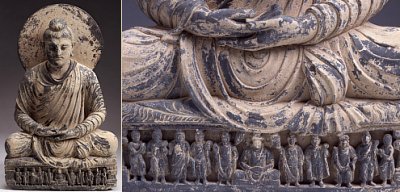
Statue from Pakistan, Gandhara, Meditation Mudra
2nd-3rd Century AD, Photo Courtesy of Miho Museum
- Five Wisdom Buddha (Transcendent / Dhyani Buddha)
- Buddha Statues from Japan, China, and SE Asia
- NOTEBOOK. Things yet to be incorporated:
MUDRA SHINGON http://www.angelfire.com/ny3/k/kuji/index.html
Kuji Goshin Ho 九字護身法
- MUDRA. http://www.metmuseum.org/special/japanese_mandalas/view_1.asp?item=13

|
|